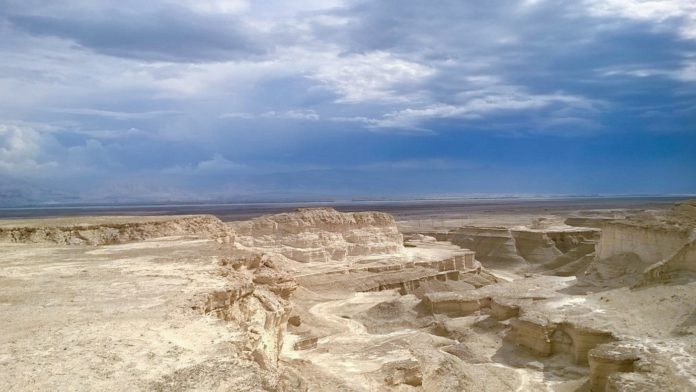The lake level of the Dead Sea is currently dropping by more than one metre every year. The main reason is heavy water consumption in the catchment area.
However, very strong lake level drops due to climate changes are also known from earlier times. At the end of the last ice age, for example, the water level dropped by almost 250 metres within a few millennia.
A study published today in the journal Scientific Reports now provides new insights into the exact course of this process.
Daniela Müller and Achim Brauer from the German Research Centre for Geosciences (GFZ) in Potsdam, together with colleagues from the Hebrew University of Jerusalem, studied 15,000-year-old sediments from the Dead Sea and the surrounding area using newly developed methods.
They show that the long period of drought was interrupted by wet periods lasting ten to a hundred years with remarkable accuracy.
This also offers new insights into the settlement history of this region. Knowledge of settlement history is significant for human development and enables better assessments of current and future developments driven by climate change.
Owing to its pivotal location as the cradle of ancient cultural developments, climatic reconstructions using Dead Sea sediments provide insights into the causes of human migration, cultural rises, and declines.
The water cycle at the Dead Sea
An in-depth understanding of the reorganization of the hydrological cycle in response to global climate change is crucial in highly sensitive regions like the eastern Mediterranean, where water availability is a major factor for socioeconomic and political development.
Geologists can achieve this by assessing strong hydroclimatic changes that occurred several millennia back in time. For example, during the transition from the last ice age to the Holocene, the water level of Lake Lisan dropped by about 240 metres in the period 24-11 thousand years ago, which eventually led to its transition into today’s Dead Sea.
Sediments as witnesses of time
The sediments at the edge of lake Lisan near the archaeological site of Masada and from the bottom of the present Dead Sea are unique witnesses to this development.
In their new study, researchers led by Achim Brauer, head of Section 4.3 “Climate Dynamics and Landscape Evolution” at the German Research Centre for Geosciences Potsdam, and doctoral student Daniela Müller together with colleagues from the Geological Survey Israel and the Hebrew University of Jerusalem, analysed these sediments with unprecedented precision. The investigations took place within the framework of the PALEX project ‘Paleohydrology and Extreme Floods from the Dead Sea ICDP Core,’ which is funded by the German Research Foundation (DFG).
Study Methodology
For this study, new high-resolution analytical methods were developed at the GFZ. To gain precise information from the stratification of the sediments and their geochemical composition, even about seasonal deposition processes and thus about the type, duration, and course of climatic phases.
In particular, the combination of light microscopic methods with so-called 2D element mapping using X-ray fluorescence scanners is new. This enables the precise identification and localisation of elements in the sediments. Important and challenging for this is the preparation of the sediments for this analysis: The moisture must be removed from them by freeze-drying — not easy given the high salt content of the Dead Sea and its affinity for water. Then the sediments are impregnated in synthetic resin, and thin sections are made from them. In all this, the microstructure must not be altered.
The researchers found that the dramatic long-term drop in the lake level due to increasing dryness was interrupted several times by wetter phases when climate change took breaks. “In this study, we were able for the first time to precisely determine the duration of these phases with several decades and in one case up to centuries by counting annual layers in the sediment,” says Daniela Müller, lead author of the study. The exact reason for these pauses in this region’s climate change still remains elusive. Possible links to the North Atlantic climate are suspected.
“What was particularly surprising was that during these wetter phases, in some cases over several decades, there we even did not find any traces of extreme floods, which are typical for this region even today and during wetter times in the past,” Müller explains.
Future climate scenarios
These results are of further interest for archaeological considerations because they coincide with the time when the Natufian culture settled in this region. Climatically stable phases could have favoured the cultural developments.
“The study shows that strong climatic changes in the past have been very dynamic and included phases of relative stability. We learn from this that climate change is not linear, but that phases of strong changes alternate with calm phases,” says Achim Brauer.
Journal Reference
- Daniela Müller, Ina Neugebauer, Yoav Ben Dor, Yehouda Enzel, Markus J. Schwab, Rik Tjallingii, Achim Brauer. Phases of stability during major hydroclimate change ending the Last Glacial in the Levant. Scientific Reports, 2022; 12 (1) DOI: 10.1038/s41598-022-10217-9
